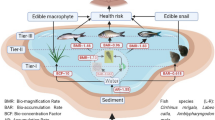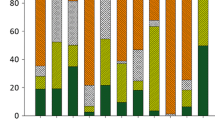Abstract
The objective of this study was to use a quantitative process-based damage assessment model (DAM) associated with biotic ligand model (BLM) to examine the ecophysiological responses of freshwater clam Corbicula fluminea to waterborne arsenic. We carried out a 14-day exposure experiment to obtain bioaccumulation parameters and a 7-day acute toxicity bioassay to obtain survival data. To investigate the survival dynamics, we examined 2 key parameters characterizing bioaccumulation and damage regulation: capacity to eliminate body arsenic burden and reversible ability to recover the damage. Results show that uptake rate constant of 2.075 ± 0.442 (mean ± SE) ml g−1 d−1 during uptake phase and elimination rate constant was estimated to be 0.1995 ± 0.022 d−1. The derived bioconcentration factor of 10.401 ml g−1 suggests that arsenic has a high potential for bioaccumulation in C. fluminea. Our results show that a negative association between bioaccumulation and the fraction of arsenic binding in biotic ligand at 50% mortality, indicating that C. fluminea with higher arsenic binding in gill biotic ligand at 50% mortality level gives a lower capacity to accumulate bioavailable arsenic. We found a linearly positive correlation between elimination rate and recovery rate constants. Yet, a potential tradeoff between ability to eliminate arsenic and ability to recover the damage is not found. We showed that an ecophysiological significance of C. fluminea exposed to arsenic can be revealed by the elimination–recovery regime. This research may also provide mechanistic insights into the development of biomonitoring organism such as C. fluminea mimicking metal bioaccumulation in a real situation.






Similar content being viewed by others
Abbreviations
- As:
-
Arsenic
- [a]:
-
Formation of the As complex with inorganic matter and binding to biotic ligand (M−1)
- {ions}:
-
Ions activity concentration (mg l−1)
- BCF:
-
Bioconcentration factor (ml g−1)
- BCF{ions}:
-
BCF of As to organism considering the competition of ions (ml g−1)
- [BL−]:
-
Biotic ligand (μg g−1)
- BLM:
-
Biotic ligand model
- C b :
-
As concentration in freshwater clam (mg g−1)
- C w :
-
Waterborne As concentration (mg l−1)
- DAM:
-
Damage assessment model
- DOC:
-
Dissolved organic carbon
- D :
-
Cumulative damage level (–)
- D 0 :
-
Threshold of cumulative damage level (–)
- D L, 50 :
-
Cumulative damage level for median lethal (–)
- DL, 50/ka:
-
Compound equivalent toxic damage level for median lethal
- \( f_{\rm AsBL}^{50\% } \) :
-
Fraction of the total number of As binding sites occupied by As at median effect (–)
- H :
-
Cumulative hazard (–)
- K ionsBL :
-
Stability constants for the binding of ions to the biotic ligand (M−1)
- k a :
-
Damage accumulation rate constant (g μg−1 d−1)
- k k :
-
Killing rate constant (g μg−1 d−1)
- k r :
-
Recovery rate constant (d−1)
- k 1 :
-
Uptake rate constant (ml g−1 d−1)
- k 2 :
-
Depuration rate constant (d−1)
- POC:
-
Particular organic carbon
- LC50:
-
External median lethal As concentration (mg l−1)
- LT50:
-
Median lethal time (d)
- S :
-
Survival probability (–)
- ST50:
-
Median survival time (d)
- WHAM:
-
Windermere humic aqueous model
References
Ashauer R, Boxal A, Brown C (2006) Predicting effects on aquatic organisms from fluctuating or pulsed exposure to pesticides. Environ Toxicol Chem 25:1899–1912
Ashauer R, Boxall ABA, Brown CD (2007a) New ecotoxicological model to simulate survival of aquatic invertebrates after exposure of fluctuating and sequential pulses of pesticides. Environ Sci Technol 41:1480–1486
Ashauer R, Boxall ABA, Brown CD (2007b) Modeling combined effects of pulsed exposure to carbaryl and chlorpyrifos on Gammarus Pulex. Environ Sci Technol 41:5535–5541
Ashauer R, Boxall ABA, Brown CD (2007c) Simulating toxicity of carbaryl to Gammarus pulex after sequential pulsed exposure. Environ Sci Technol 41:5528–5534
Buchwalter DB, Cain DJ, Martin CA, Xie L, Luoma SN, Garland TJ (2008) Aquatic insect ecophysiological traits reveal phylogenetically based differences in dissolved cadmium susceptibility. Proc Natl Acad Sci USA 105:8321–8326
Cherry DS, Soucek DJ (2007) Gase study: comparison of Asian clam (Corbicula fluminea) in situ testing to several nontarget test organism response to biocidal dosing at a nuclear power plant. In: Farris JL, van Hassel JH (eds) Freshwater bivalve ecotoxicology. CRC Press, Boca Raton, FL
Croteau MN, Luoma SN (2009) Predicting dietborne metal toxicity from metal influxes. Environ Sci Technol 43:4915–4921
De Schamphelaere KAC, Janssen CR (2002) A biotic ligand model predicting acute copper toxicity for Daphnia magna: the effect of calcium, magnesium, sodium, potassium, and pH. Environ Sci Technol 36:48–54
Diamond JM, Klaine SJ, Butcher JB (2006) Implications of pulsed chemical exposures for aquatic life criteria and wastewater permit limits. Environ Sci Technol 40:5132–5138
Dietz TH, Byrne RA (1990) Potassium and rubidium uptake in fresh-water bivalves. J Exp Biol 150:395–405
Fergusion JF, Gavis J (1972) A review of the arsenic cycle in natural waters. Water Res 6:1259–1274
Gerhardt A, de Bisthoven LJ, Soares AMV (2005) Evidence for the stepwise stress model: Gambusia holbrooki and Daphnia magna under acid mine drainage and acidified reference water stress. Environ Sci Technol 39:4150–4158
Jorgensen CB (1996) Bivalve filter feeding revisited. Mar Eco-Prog Ser 142:287–302
Jou LJ, Chen WY, Liao CM (2009) Online detection of waterborne bioavailable copper by valve daily rhythms in freshwater clam Corbicula fluminea. Environ Monit Assess 155:257–272
Lee JH, Landrum PF, Koh CH (2002) Prediction of time-dependent PAH toxicity in Hyalella azteca using a damage assessment model. Environ Sci Technol 36:3131–3138
Liao CM, Lin CM, Jou LJ, Chiang KC (2007) Linking valve closure behavior and sodium transport mechanism in freshwater clam Corbicula fluminea in response to copper. Environ Pollut 147:656–667
Luoma SN, Rainbow PS (2005) Why is metal bioaccumulation so variable? Biodynamics as a unifying concept. Environ Sci Technol 39:1921–1931
National Researcher Council (NRC) (2001) Arsenic in drinking water. National Academy Press, Washington DC
Newton TJ, Cope WG (2007) Biomarker response of unionid mussels to environmental contaminants. In: Farris JL, van Hassel JH (eds) Freshwater bivalve ecotoxicology. CRC Press, Boca Raton, FL
Niyogi S, Wood CM (2004) Biotic ligand model, a flexible tool for developing site-specific water quality guidelines for metals. Environ Sci Technol 38:6177–6190
Paquin PR, Zoltay V, Winfield RP, Wu KB, Mathew R, Santore RC, Di Toro DM (2002) Extension of the biotic ligand model of acute toxicity to a physiologically-based model of the survival time of rainbow trout (Oncorhynchus mykiss) exposed to silver. Comp Biochem Physiol C Pharmacol Toxicol Endocrinol 133:305–343
Reinert KH, Giddings JM, Judd L (2002) Effect analysis of time-varying or repeated exposures in aquatic ecological risk assessment of agrochemicals. Environ Toxicol Chem 21:1977–1992
Shaw JR, Glaholt SP, Greenberg NS, Sierra-Alvarez R, Folt CL (2007) Acute toxicity of arsenic to Daphnia pulex: influence of organic functional group and oxidation state. Environ Toxicol Chem 26:1532–1537
Thorsen WA, Cope WG, Shea D (2007) Toxicokinetics of environmental contaminations in freshwater bivalves. In: Farris JL, van Hassel JH (eds) Freshwater bivalve ecotoxicology. CRC Press, Boca Raton, FL
Tsai JW, Chen WY, Ju YR, Liao CM (2009) Bioavailability links mode of action can improve the long-term field risk assessment for tilapia exposed to arsenic. Environ Int 35:727–736
Zheng H, Dietz TH (1998) Ion transport in the freshwater bivalve Corbicula fluminea. Biol Bull 194:161–169
Author information
Authors and Affiliations
Corresponding author
Rights and permissions
About this article
Cite this article
Chen, WY., Liao, CM. Dynamic features of ecophysiological response of freshwater clam to arsenic revealed by BLM-based toxicological model. Ecotoxicology 19, 1074–1083 (2010). https://doi.org/10.1007/s10646-010-0489-9
Accepted:
Published:
Issue Date:
DOI: https://doi.org/10.1007/s10646-010-0489-9




